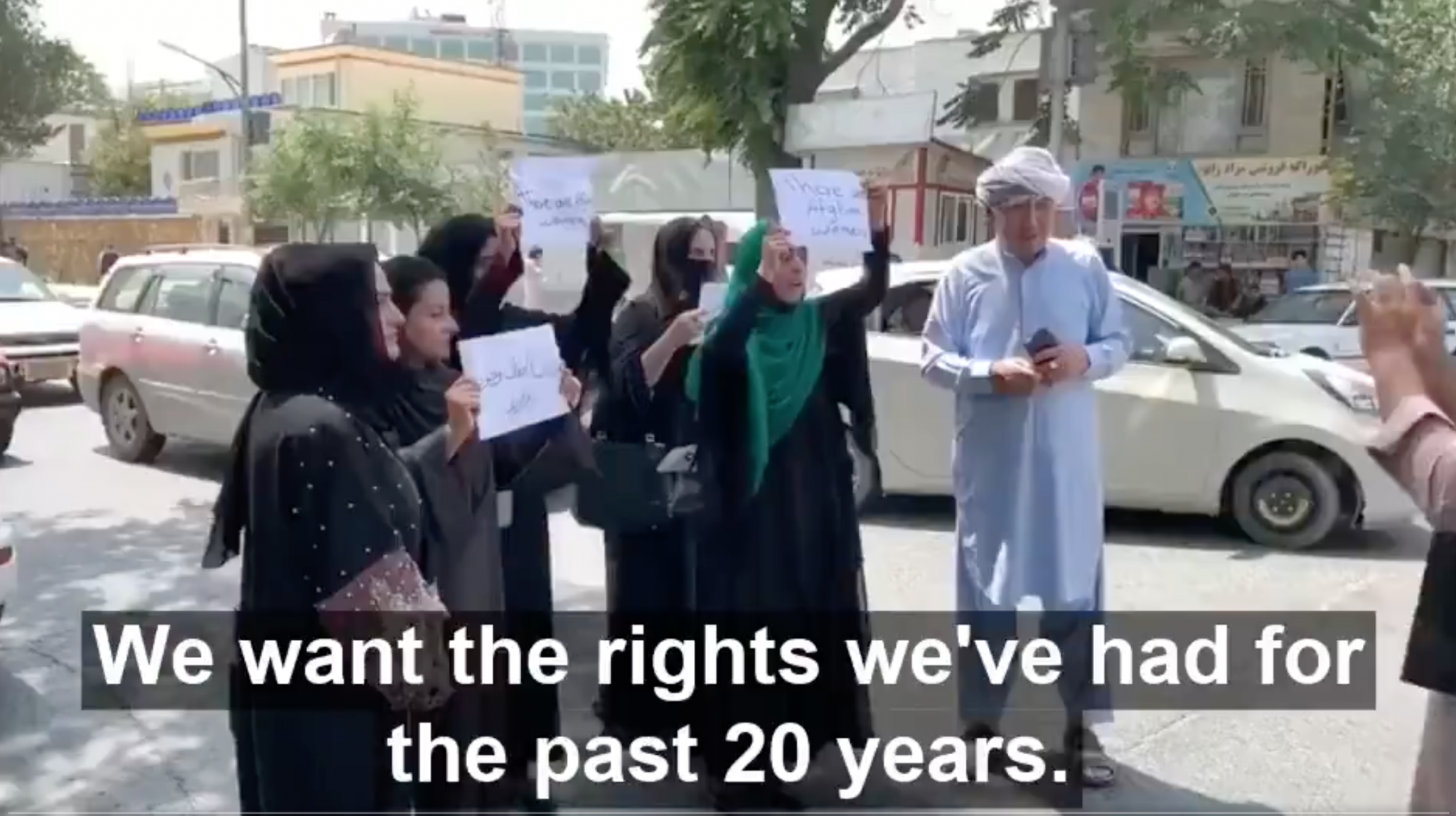
As the Taliban, now in full control of Kabul, pledge an “inclusive” Afghan government in prepared press statements, deadly repression against anti-Taliban protesters is reported from the eastern city of Jalalabad. On Aug. 18, the day before Afghanistan’s independence day, protesters took to the streets of Jalalabad waving the black, red and green national flag—and tearing down the white and black Tawhid flag of the Taliban. Witnesses said Taliban fighters fired on protesters indiscriminately, and at least three were killed. (Khaama, Khaama, Sky News, UNILAD, TOLO News) On Aug. 19, the day Afghanistan won full independence from Britain in 1919, a similar protest was held in Khost, where social media videos again show Taliban fighters firing on demonstrators. No casualties were reported, but the city has been placed under a 24-hour curfew. (AP, CNN, Latestly)
A small demonstration by women demanding that their rights be respected was held Aug. 17 outside a police precinct in Kabul. “We want the rights we’ve had for the past 20 years,” signs read. Taliban fighters looked on but did not interfere. (Khaama, Indian Expess) Independence Day also saw protests in Kabul, with hundreds marching to the presidential palace, holding aloft large national flags. (NYT) Social media videos show Taliban fighters raising their rifles at protesters but not firing. An evening curfew has also been imposed in Kabul. (Khaama)
Who is in charge?
Social services are paralyzed in Kabul, and aid organizations warn of a “humanitarian disaster” in the city and throughout the country if effective governance is not restored soon. (NYT) On Aug. 18, a delegation of Taliban leaders led by Sirajuddin Haqqani met in Kabul with former president Hamid Karzai and the head of High Council for National Reconciliation, Abdullah Abdullah. Fazal Haid Muslimyar, speaker of the House of Elders (upper chamber of the National Assembly), was also said to be at the closed-doors meeting, from which media were barred. (Khaama) The Taliban’s most visible leader, Mullah Abdul Ghani Baradar, has reportedly flow in from Qatar to Kandahar, and is expected to arrive in Kabul. (Khaama)
While Haibatullah Akhundzada is the Taliban’s official leader, Baradar is its effective political chief. A veteran of the Mujahedeen war against the Soviets in the 1980s, Baradar established Kandahar as the Taliban’s support base in the ’90s, together with his reported brother-in-law, the organization’s late first leader Mullah Mohammad Omar. After the US invasion of 2001, he helped direct the Taliban insurgency from exile in Pakistan. The CIA tracked him down to Karachi in 2010, and in February of that year the US persuaded Pakistani authorities to arrest him. However, he was freed in 2018—at the behest of Washington. Donald Trump’s Afghan envoy, Zalmay Khalilzad, asked the Pakistanis to release him so he could lead the negotiations in Qatar. In February 2020, US Secretary of State Mike Pompeo met with Baradar at a highly publicized conference, where Khalilzad and the Mullah signed the Doha Agreement, ostensibly ending the US war against the Taliban. (MEAWW, The Guardian)
Hazara face fear, exodus
There is especially fear in central Bamiyan province, homeland of the Hazara Shi’ite minority, who were targeted for genocide by the Taliban when they were in power in the ’90s. Taliban fighters now in control of the provincial capital have blown up a statue there of the Hazara Mujahedeen leader Abdul Ali Mazari, who was executed by the Taliban in 1995. In addition to being seen as direct threat to the Hazara, for many this was a grim reminder of the Taliban’s destruction of the nearby Bamiyan Buddhas in 2001. (NDTV)
Hundreds of Hazara families are reported to have fled Bamiyan, seeking shelter with the incipient resistance forces organizing in the Panjshir Valley.
The website Hazara.net protests that the ethnicity was put at risk by the release of 5,000 Taliban prisoners by Afghan authorities last year, which the US signed off on as part of the Doha Agreement. Hazara.net also bitterly recalls the release of the so-called Gitmo 5 in 2014—Taliban leaders flown from Guantánamo Bay to Qatar in exchange for captured US Army soldier Sgt. Bowe Bergdahl. According to Hazara.net, these included figures “involved in massacres of peaceful Hazaras.”
India’s Hindustan Times provides a breakdown of the Gitmo 5. They were: Khairullah Khairkhwa, who went on to become a key strategist of the Taliban’s resurgence; Mohammed Nabi, who served as Taliban chief of security in Qalat in the ’90s; Abdul Haq Wasiq, who served as the Taliban deputy minister of intelligence; Mullah Norullah Nori, a senior Taliban commander in Mazar-e-Sharif; and Mohammad Fazl, who according to human rights groups “presided over the mass killing of Shiite Muslims in Afghanistan in 2000 and 2001.”
Photo via Twitter





Taliban fire on protesters in Asadabad
Taliban fighters on Aug. 19 fired on protesters waving the national flag in the city of Asadabad, Kunar province, which led to a stampede, killing many. Protesters in Asadabad were waving the national flag after tearing down the white flags of the Taliban. It is unclear whether the casualties resulted directly from the firing or the subsequent stampede. (Hindustan Times)